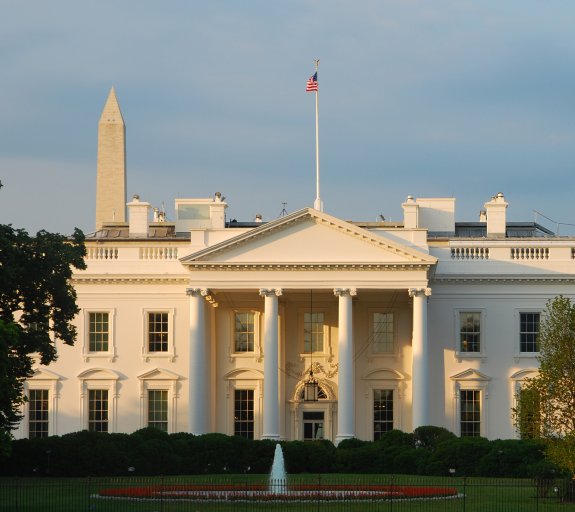
AXA IM US election reaction: what Trump's win means for markets and investors
KEY POINTS
At the time of writing (midday on Wednesday, 6 November), former President Donald Trump has won the 2024 US presidential election. In a much quicker than expected result, Trump currently has 279 Electoral College votes versus 223 for his opponent Kamala Harris. Trump has been declared winner in the key swing states of Georgia, North Carolina, Pennsylvania and Wisconsin. This rules out Harris’ path to victory.
Despite polls continually suggesting this would be the tightest race on record, the outcome has not borne this out. Trump is on track to comfortably win the popular vote: he currently has 51.0% of the vote vs Harris with 47.5%, with the Associated Press reporting gains in the Republican vote in every state bar Washington and Utah. World leaders have congratulated Trump on his win, including Canada’s Justin Trudeau, the UK’s Keir Starmer and France’s Emmanuel Macron, as well as leaders from India, Israel and Ukraine.
View from Chris Iggo, CIO, AXA IM Core: Trump 2.0 sends bond yields and equities higher (2016 redux)
Markets have responded as expected to Donald Trump’s victory – higher Treasury bond yields, firmer equities, and a stronger dollar. It is a re-run of 2016. In 2016, 10-year Treasury yields bottomed in July and rose 40 basis points (bp) before the election. They shot up another 85bp in the month or so after the election, reaching 2.65% from 1.80% on the day of the vote. After that they traded sideways to lower, until rising again in late 2017 to November 2018, peaking at 3.20%. On a net basis from the low below the election to the peak two years after Trump’s victory, yields rose by 180bp.
This year yields bottomed in September and had already risen 62bp by election day. If the pattern of 2016 is to be repeated, then we could be looking at yields continuing to increase another 100bp or so over the next year or two, giving a nominal yield of around 5.5%. However, the pattern of 2016 saw yields not really move that much higher after the initial post-election jump. Between the end of November 2016 and November 2017, the ICE BofA US Treasury index’s total return was +2.0%. Yields actually fell for part of that period.
Again, the fundamental story would be Trump’s supposed preference for policies that would be fiscally expansionary and inflationary and whether this will prevent the Federal Reserve (Fed) from cutting interest rates as much as the market had hoped. Growth is arguably above trend, inflation is still above target, and so the Fed might need to keep rates on the tighter side of neutral for longer.
In 2016 to 2018 the Fed was tightening monetary policy. That helped send bond yields higher. Yields peaked in November 2018; the Fed Funds Rate peaked in December. The Fed tightened by 200bp; bond yields rose by 180bp. In 2024, the Fed is easing, and we do expect more easing. That may limit the extent to which yields will rise. Also, real yields are much higher today, which also may strengthen the argument that yields will not need to rise as much. In fact, real yields are high across the curve given the decline in inflation. Any higher and they will start to raise the likelihood of a hard landing.
How the market eventually trades depends on initial sentiment (reflation, higher rates and equities, stronger dollar); actual policy decisions (we won’t know until January at the earliest what the Trump Administration can actually do and whether the president will go all in on tax cuts and import tariffs); and the behaviour of consumers and businesses towards the proposed policies and how it impacts their spending, pricing behaviour and wage demands. Real yields are getting close to levels suggested by real GDP growth. There may also be a fiscal risk premium embedded in longer-term yields. They are relatively higher by recent standards. Equities (currently expensive) have gone up in price; bonds (fair value to cheap) have gone down in price. Policy uncertainty puts risky assets more at risk.
View from David Page, Head of Macro Research, AXA IM: Trump sweep replaces political uncertainty for policy uncertainty
The scale of victory has spilled over to Congress. As we had considered very likely, the Senate has returned a Republican majority. Joe Manchin’s empty Democrat seat in West Virginia flipped to Republican and Democrat Sherrod Brown lost in Ohio; the net gain of two seats giving Republicans an outright majority of 51-42 at the time of writing. Republicans might pick up an extra seat or two in the remaining counts. The House of Representatives election is not as conclusive and was something that we had considered to be a closer call, although we ultimately predicted that this would go with the presidential vote. At the time of writing, the Republicans have 197 seats – still short of the 218 required for a majority – but significantly ahead of the Democrat’s 180, with 58 left to declare. Moreover, Republicans already held a razor thin majority of 222 to 213 after the 2022 elections and have so far seen a net gain of three seats, suggesting that they are on track to retain the majority there. This leaves President-elect Donald Trump on track to deliver a Republican sweep, which despite recognising significant uncertainty has been our base case scenario since July1.
Today’s results provide a welcome clarity over the political outlook – and one that has been delivered more quickly than expected. However, uncertainty over the US outlook now shifts from political uncertainty to policy uncertainty. On the campaign trail Trump had been clear on the themes he would focus on during a second term, albeit less consistent on the detail. From an economic perspective these have focused on tariffs, migration, fiscal easing and deregulation. In our recent experience, investors have consoled themselves by reflecting that many of these themes are those that were entertained, but not delivered – at least not to the extent promised - during his first term and assume similar for a second term. We fear that this is complacent. Much frustration with Trump’s first term reflected his inexperience with the machinery of state. The thrust of Project 2025 and other preparations has been to make his second term much more effective at delivering on policy promises. We question whether Trump will truly deliver a 10% blanket global tariff and 60% tariff on China; whether he will deport the eight million-plus undocumented migrants in the US; and doubt that the Republican administration will deliver the full extent of fiscal easing trailed by Trump. But we believe that he will come out of the stalls moving in all of these directions in 2025, with marked implications for the US economic outlook.
While we assume many of these policies will take time to implement, we expect to see some tariff increases, restricted migrant flows and moves towards a fiscal easing package across the course of 2025. We will publish our full 2025 and 2026 forecasts in our economic Outlook on 4 December. However, we consider tariffs and migration restriction to be supply shocks and fiscal easing to be a demand boost. This is likely to see US inflation reaccelerate – perhaps sharply depending on the scale and pace of tariffs.
In terms of growth, depending on financial market reaction, we expect US activity to remain solid into 2025 – softening from a robust 2.8% expected for 2024, but likely remaining above trend at 2.3% for 2025. However, assuming broad implementation of Trump’s policies across 2026, we expect to see material headwinds to growth in 2026. We believe that rising inflation will restrict the Federal Reserve’s (Fed) space for policy easing. In growing anticipation of a Trump win (and in the light of firmer data) markets had scaled back expectations for Fed cuts to take the benchmark rate to 4.00% by end-2025 from 3.00% after the Fed’s surprise 50 basis point cut in September. Indeed, while we expect the Fed to proceed with 0.25% cuts in the next successive meetings (November and December) to 4.50%, we then only pencil in one more rate cut in March to 4.25%. However, we do see the risk of a marked slowdown in growth seeing the Fed resume cuts again in 2026.
Above and beyond these economic measures, we also are wary of some of geopolitical dynamics impacting financial market and economic outlooks. Trump has repeatedly said that he could settle the Russia-Ukraine conflict in his first day. We fear that this risks forcing a settlement on Ukraine by removing military support. This could have implications for European security developments over the rest of this decade and impact European defence spending and public finances.
Moreover, regardless of the scale of measures, it appears clear that Trump will increase trade tensions with China again, impacting their already fragile economic outlook. The Chinese authorities are concurrently holding policy meetings with a view to targeting and announcing a new range of stimulus measures, in part accounting for the new direction of US policy. But this may further stretch geopolitical tensions, which had improved somewhat in recent years. Finally, the Middle East is in a delicate balance for now. Geopolitical tensions have been in an uneasy equilibrium over recent years and Trump’s statements suggest that he could significantly change this balance. We do not know where the geopolitical equilibrium would settle after this but consider associated risks to financial market sentiment.
Several of these developments appear to be playing through financial markets – and indeed had underpinned a broad move towards ‘Trump trades’ over the last few weeks. While short-term interest rate expectations were little changed, expectations for the Fed’s rate by next September had risen over the last two weeks, and are up 11bp from Tuesday morning, consistent with concerns surrounding the Fed’s space to ease. Overnight, two-year Treasury yields rose by 8bp to 4.26%. 10-year yields posted a larger 17bp rise to 4.44%, also reflecting a rise in longer-term inflation expectations and possibly considering longer-term fiscal sustainability concerns. The dollar also gained - having softened by 0.5% against a basket of currencies on Tuesday, the dollar gained by 1.5% overnight to a four-month high – likely anticipating firmer rate differentials and an impact from tariffs. Finally, following a 1.2% gain on Tuesday, S&P futures point to further gains today – as markets plausibly anticipate gain from deregulation.
- {https://www.axa-im.com/investment-institute/macroeconomics/us-2024-presidential-election-preview-trump-faces-new-adversary;US 2024 presidential election preview: Trump faces new adversary}
View from Gilles Moëc, AXA Group Chief Economist and AXA IM Head of Research: US election results mean ECB will have to accelerate rate cuts
At this stage, it seems the Republicans could even secure a ‘full sweep’: winning the presidency and the Senate, while possibly keeping their narrow majority in the House. For the latter, results will take time to come in full but for now the Republicans seem to be holding up reasonably well in their 'at risk' seats. Such a configuration would enable and incentivise Donald Trump to 'go fast' on the delivery of his platform (after the 2026 mid-terms his party will be entirely focused on his succession).
Now, with a narrow majority in the House, the fiscal conservatives in the Republican Party have a capacity to try to moderate Trump's projects - which according to the Penn Wharton Budget Model would raise the deficit by close to 2% of GDP annually. But if Trump is 'stopped out' on tax - which would also happen if the Democrats were to flip the House - he could tempted to compensate by going all-in on trade tariffs (on which he has control) and immigration (ditto). Alternatively, he could present to reluctant Republicans the revenue of the trade tariffs as a way to fund his tax cuts.
Either way, this is consistent with higher interest rates, with inflation rising as a result of the immigration crackdown (without net inflows of around 2% of the workforce last year inflation would not have landed in the US) and tariffs, and/or the supply of Treasury bonds rising significantly.
In Europe, the main takeaway is that the European Central Bank (ECB) will need to accelerate its interest rate cuts. The economy is unlikely to improve as a ‘wait and see’ attitude could prevail in export-oriented businesses. The 10% tariff itself on European products is probably manageable, but the 60% one on Chinese products could be very disruptive, either by lowering Chinese demand or by triggering a massive devaluation of the yuan, and/or incentivising Chinese producers to compete more fiercely with European suppliers outside the US market. Energy price volatility could be another source of uncertainty, as the potential of further escalation of conflict in the Middle East has just risen again.
European national governments are not in an ideal position to provide reassurance or guidance, with both France and Germany in the midst of domestic political difficulties, while the European Union populists will want to push their advantage. The ECB is the only European institution with capacity to respond swiftly in the current configuration.
We have seen some contagion from US long-term yields on European yields recently, and this won’t help Europe’s fiscal equation. This is another reason the ECB will have to compensate with faster cuts. Fortunately, it seems that even the hawks are changing their tune at the ECB.
Source for all data: Bloomberg, as of 6 November 2024
Disclaimer
This document is for informational purposes only and does not constitute investment research or financial analysis relating to transactions in financial instruments as per MIF Directive (2014/65/EU), nor does it constitute on the part of AXA Investment Managers or its affiliated companies an offer to buy or sell any investments, products or services, and should not be considered as solicitation or investment, legal or tax advice, a recommendation for an investment strategy or a personalized recommendation to buy or sell securities.
Due to its simplification, this document is partial and opinions, estimates and forecasts herein are subjective and subject to change without notice. There is no guarantee forecasts made will come to pass. Data, figures, declarations, analysis, predictions and other information in this document is provided based on our state of knowledge at the time of creation of this document. Whilst every care is taken, no representation or warranty (including liability towards third parties), express or implied, is made as to the accuracy, reliability or completeness of the information contained herein. Reliance upon information in this material is at the sole discretion of the recipient. This material does not contain sufficient information to support an investment decision.
Issued in the UK by AXA Investment Managers UK Limited, which is authorised and regulated by the Financial Conduct Authority in the UK. Registered in England and Wales, No: 01431068. Registered Office: 22 Bishopsgate, London, EC2N 4BQ.
In other jurisdictions, this document is issued by AXA Investment Managers SA’s affiliates in those countries.
© 2024 AXA Investment Managers. All rights reserved
Image source: Getty Images




